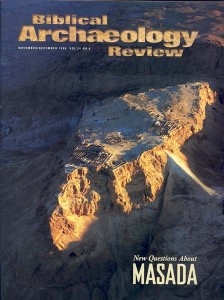Roman Warfare
Sidebar to: Governments-in-Exile

Roman forces in Palestine left behind vestiges of their body gear and weaponry, evidence that Jewish freedom fighters in their desert redoubts faced formidable opponents.
This second-century A.D. bronze helmet (below) has three typical elements: a skull-plate, or cassis, with a browguard to protect the face against downward blows; cheek pieces to protect the sides of the face; and a neckguard to cover the back of the neck. On many helmets, a special fitting permitted the attachment of a crest.

The bronze scales shown here (below) are but a handful of more than 1,000 found at Masada. Originally attached to a fabric backing to create a form-fitting hip-length garment, the scales were cut from cast sheet metal. Like these examples, most of the scales found at Masada have four holes in a square pattern and are strengthened by a rib in the center and a raised border.
Already a library member? Log in here.
Institution user? Log in with your IP address.

